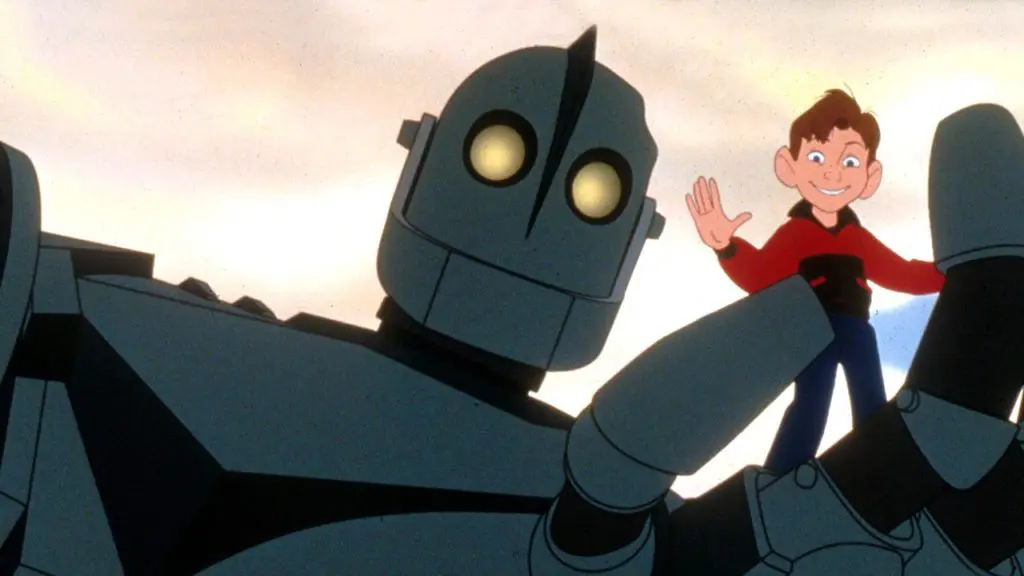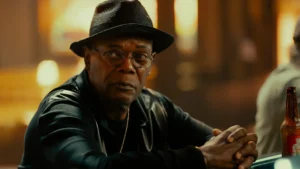Today marks the 20-year anniversary of much loved classic animation The Iron Giant. The endearing tale of a giant heroic robot from outer space won the hearts of audiences for its combination of youthful charm and mature sophistication. This being so, The Iron Giant was anything but an instant classic. Considered a box office failure, The Iron Giant still remains one of Warner Bros’ biggest losses. With a budget of $70 million dollars, the movie went on to make only $80 million (estimated) in cumulative sales worldwide. Regardless of profit, The Iron Giant is well remembered and highly regarded by critics and audiences alike and its worth should be measured by its mark on animation history rather than its profit (or lack of).
Set in the 1950s The Iron Giant tells the story of a young boy named Hogarth who finds himself in an impossible situation as he attempts to protect a giant robot from the power of the US military. Upon discovering the Iron Giant, Hogarth’s curiosity trumps his fear as he befriends the robot who’s innocence and naivety warrants an immediate reaction of protection. After a paranoid government agent by the name of Kent discovers the giant’s existence he takes it upon himself to stop at nothing to ensure it’s destruction. Hogarth is left with no choice but to attempt concealment at a local junkyard with the hopes that his new robot friend will be indistinguishable amongst the mounds of metal debris.
Voiced by Vin Diesel the Iron Giant is the literal personification of a weapon of mass destruction. Given a heart of gold and an innocent mentality, the character’s wide-eyed view of earth is curiously ironic given its purpose as a violent machine. The idea of bringing a weapon to life came from an understandably haunting real-life consequence of gun violence. Director Brad Bird’s sister tragically lost her life at the hands of her husband due to gun violence and this ultimately led Bird to pitch the idea of ‘What if a gun has a soul and didn’t want to be a gun?’. These serious undertones and themes of politics, terror, and paranoia juxtaposed with the playful and childish friendship between the protagonists make The Iron Giant an inspiringly sophisticated animation.
Given the state of current affairs, especially on the topic of gun violence and the mass fear of terrorism, themes of The Iron Giant are just as prevalent as they have always been. By the same token, The Iron Giant is not like your standard children’s film, it does not make 2D of any character, giving younger audiences a glimpse into a reality that is not black and white, where the grey areas are enacted with meaningful clarity. One prominent idea explored within the film is the notion that the military and the government are essentially just as naïve and ignorant as the child Hogarth. Unfortunately, unlike Hogarth, who greeted the giant with wonder and intrigue the adults’ immediate reaction to the discovery of the machine is fear and retaliation. This ultimately reflects the chaos that ensues through misinformation and mass panic, a primitive fear for the unknown. A problem that still plagues modern society today whether it be fear or aggression that stems from unknown differences in culture, religion or sexuality.
As serious as that all sounds The Iron Giant is still beautifully playful, and seeing the world through Hogarth’s and the Giant’s eyes is nothing short of endearing. The Giant, a sentient machine has an infant-like perspective of the world that encourages audiences to coo his curious nature. Likewise, Hogarth has an infectious passion for the unknown with his childlike bewilderment and inquisitiveness that gives audiences plenty of cheeky, fun-filled moments of joy. Not only this, the older audience appreciate the well written, intelligent and witty adult characters that hilariously translate the troubles of adult responsibility.
The Iron Giant was not only acclaimed for its narrative but also for the production team’s animating methods. The movie became the first of it’s kind to combine traditional animating techniques with a completely computer-generated main protagonist. This leap in style meant the design team had to create their own software in order to ensure the smooth integration of the CGI Giant onto a 2D world. The overall effect was glorious as the programming worked to add motion to the Giant’s borderlines in order to mimic the effect and style of the traditionally animated surroundings. The Giant’s size, motion, and scale are clear to see as he navigates the environment and I have no doubt the colossal sense of being can be attributed to the assimilation of the 3D-like animation.
Overall, The Iron Giant is eloquent and touching, offering audiences a refined version of what a children’s movie can be. With a poignant storyline and inspirational protagonists, The Iron Giant is nothing short of inspiring. Willing audiences to do the right thing in life no matter what the situation or how badly you want to retaliate. The Iron Giant will make you fall in love with a robot from space and will break your heart when he becomes his very own Superman. After 20 years maybe now is as good a time as any to revisit The Iron Giant and rekindle your love for Hogarth and his guardian angel from another galaxy.




